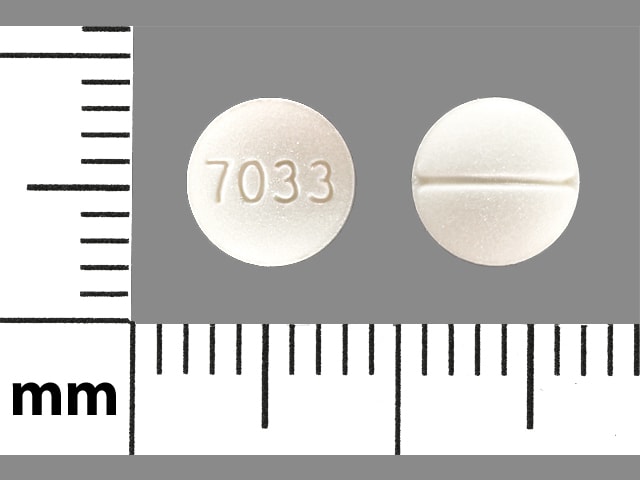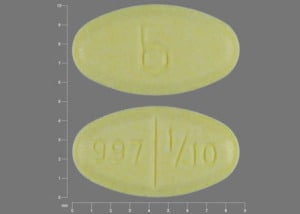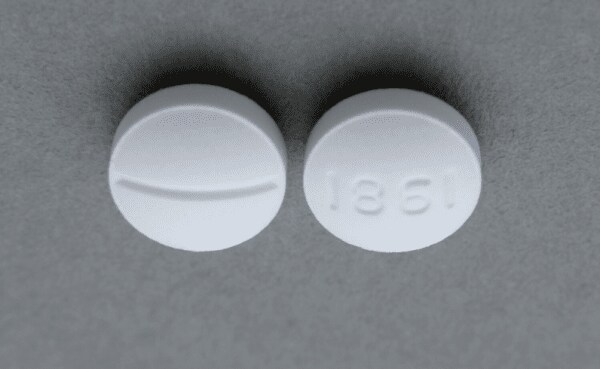Dosage Forms
Excipient information presented when available (limited, particularly for generics); consult specific product labeling.
Tablet, Oral, as acetate:
Generic: 0.1 mg
Pharmacology
Mechanism of Action
Very potent mineralocorticoid with high glucocorticoid activity; used primarily for its mineralocorticoid effects. Promotes increased reabsorption of sodium and loss of potassium from renal distal tubules.
Pharmacokinetics/Pharmacodynamics
Metabolism
Hepatic
Half-Life Elimination
Plasma: ≥3.5 hours; Biological: 18 to 36 hours
Use: Labeled Indications
Adrenal insufficiency, primary (Addison disease): Partial replacement therapy for primary adrenocortical insufficiency
Congenital adrenal hyperplasia, classic (salt-losing adrenogenital syndrome): Treatment of classic congenital adrenal hyperplasia (salt-losing adrenogenital syndrome)
Use: Off Label
Idiopathic orthostatic hypotensioncyes
Clinical experience suggests that fludrocortisone in conjunction with increased sodium intake may be beneficial for the treatment of idiopathic orthostatic hypotension Kearney 2009, Lanier 2011. Additional data may be necessary to further define the role of fludrocortisone for this condition.
Based on the European Federation of Neurological Societies (EFNS) guidelines on the diagnosis and management of orthostatic hypotension, fludrocortisone is effective and recommended as first-line monotherapy for the management of orthostatic hypotension.
Septic shockb
Data from two double-blind, placebo controlled, randomized trials suggest the combination of hydrocortisone plus fludrocortisone may be beneficial in patients with septic shock refractory to initial volume resuscitation and vasopressors. In these trials, hydrocortisone plus fludrocortisone improved mortality compared to placebo and also aided in more rapid reversal of shock Annane 2002, Annane 2018. Note: Corticosteroids should not be administered for the treatment of sepsis in the absence of shock or for septic shock that is responsive to fluid resuscitation and vasopressors. Some experts only use hydrocortisone monotherapy without fludrocortisone when corticosteroids are indicated Rhodes 2017, SCCM/ESICM [Annane 2017].
Contraindications
Hypersensitivity to fludrocortisone or any component of the formulation; systemic fungal infections
Documentation of allergenic cross-reactivity for corticosteroids is limited. However, because of similarities in chemical structure and/or pharmacologic actions, the possibility of cross-sensitivity cannot be ruled out with certainty.
Dosage and Administration
Dosing: Adult
Adrenal insufficiency, primary (Addison disease): Oral: Initial: 0.05 to 0.1 mg once daily in the morning (in combination with hydrocortisone or cortisone). Usual maintenance dose: 0.05 to 0.2 mg once daily. If hypertension develops, dose reduction is suggested; an antihypertensive may be necessary if hypertension remains uncontrolled (Endocrine Society [Bornstein 2016]).
Manufacturer's labeling: Dosing in the prescribing information may not reflect current clinical practice. 0.1 mg daily; if transient hypertension develops, reduce dose to 0.05 mg daily; maintenance dosage range: 0.1 mg 3 times weekly to 0.2 mg daily.
Congenital adrenal hyperplasia, classic (salt-losing adrenogenital syndrome): Oral: 0.05 to 0.2 mg/day in 1 or 2 divided doses (in combination with glucocorticoid therapy) (Endocrine Society [Speiser 2018])
Orthostatic hypotension (off-label use; Kearney 2009; Lahrmann 2006; Lanier 2011): Oral: Initial: 0.1 mg daily in conjunction with a high-salt diet and adequate fluid intake; may be increased in increments of 0.1 mg per week; maximum dose: 1 mg daily. Note: Doses exceeding 0.3 mg daily may not be beneficial and predispose patient to unwanted side effects (eg, hypertension, hypokalemia).
Septic shock (off-label use): Note: Corticosteroids should only be used for septic shock that is not responsive to volume resuscitation and vasopressors (Rhodes 2017; SCCM/ESICM [Annane 2017]). Oral: 0.05 mg once daily (via nasogastric tube) for 7 days (in combination with IV hydrocortisone) (Annane 2002; Annane 2018).
Dosing: Geriatric
Refer to adult dosing.
Dosing: Pediatric
Note: Dosing should be individualized to lowest effective dose.
Adrenal insufficiency, autoimmune (aldosterone deficiency component Addison’s disease); replacement therapy: Limited data available: Oral: 0.05 to 0.2 mg daily (Betterle, 2002; Kliegman, 2011)
Congenital adrenal hyperplasia (salt losers) (eg, 21-hydroxylase deficiency): Limited data available: Note: Use in combination with glucocorticoid therapy (eg, hydrocortisone); concurrent sodium replacement therapy may be required, particularly in young infants. Oral: Maintenance therapy:
Infants, Children, and Adolescents (actively growing): Usual range: 0.05 to 0.2 mg daily in 1 or 2 divided doses; doses as high as 0.3 mg/day may be necessary (AAP, 2000; AAP, 2010; Speiser, 2010)
Adolescents (fully grown): 0.05 to 0.2 mg once daily (AAP, 2010; Speiser, 2010)
Administration
Oral: Administer without regard to food; if GI upset, may take with food. For septic shock (off-label use), administer via nasogastric tube (Annane 2002; Annane 2018)
Dietary Considerations
Systemic use of mineralocorticoids/corticosteroids may require a diet with increased potassium, vitamins A, B6, C, D, folate, calcium, zinc, and phosphorus, and decreased sodium. With fludrocortisone, a decrease in dietary sodium is often not required as the increased retention of sodium is usually the desired therapeutic effect.
Storage
Store at 15°C to 30°C (59°F to 86°F); avoid excessive heat. The Canadian labeling recommends to store at 2°C to 8°C (36°F to 46°F).
Fludrocortisone Images
Drug Interactions
Acetylcholinesterase Inhibitors: Corticosteroids (Systemic) may enhance the adverse/toxic effect of Acetylcholinesterase Inhibitors. Increased muscular weakness may occur. Monitor therapy
Aldesleukin: Corticosteroids may diminish the antineoplastic effect of Aldesleukin. Avoid combination
Amphotericin B: Corticosteroids (Systemic) may enhance the hypokalemic effect of Amphotericin B. Monitor therapy
Androgens: Corticosteroids (Systemic) may enhance the fluid-retaining effect of Androgens. Monitor therapy
Antacids: May decrease the bioavailability of Corticosteroids (Oral). Management: Consider separating doses by 2 or more hours. Budesonide enteric coated tablets could dissolve prematurely if given with drugs that lower gastric acid, with unknown impact on budesonide therapeutic effects. Consider therapy modification
Antidiabetic Agents: Hyperglycemia-Associated Agents may diminish the therapeutic effect of Antidiabetic Agents. Monitor therapy
Aprepitant: May increase the serum concentration of Corticosteroids (Systemic). Management: No dose adjustment is needed for single 40 mg aprepitant doses. For other regimens, reduce oral dexamethasone or methylprednisolone doses by 50%, and IV methylprednisolone doses by 25%. Antiemetic regimens containing dexamethasone reflect this adjustment. Consider therapy modification
Axicabtagene Ciloleucel: Corticosteroids (Systemic) may diminish the therapeutic effect of Axicabtagene Ciloleucel. Management: Avoid use of corticosteroids as premedication before axicabtagene ciloleucel. Corticosteroids may, however, be required for treatment of cytokine release syndrome or neurologic toxicity. Consider therapy modification
Baricitinib: Immunosuppressants may enhance the immunosuppressive effect of Baricitinib. Management: Use of baricitinib in combination with potent immunosuppressants such as azathioprine or cyclosporine is not recommended. Concurrent use with antirheumatic doses of methotrexate or nonbiologic disease modifying antirheumatic drugs (DMARDs) is permitted. Consider therapy modification
BCG (Intravesical): Immunosuppressants may diminish the therapeutic effect of BCG (Intravesical). Avoid combination
Bile Acid Sequestrants: May decrease the absorption of Corticosteroids (Oral). Monitor therapy
Calcitriol (Systemic): Corticosteroids (Systemic) may diminish the therapeutic effect of Calcitriol (Systemic). Monitor therapy
Cladribine: May enhance the immunosuppressive effect of Immunosuppressants. Avoid combination
Coccidioides immitis Skin Test: Immunosuppressants may diminish the diagnostic effect of Coccidioides immitis Skin Test. Monitor therapy
Corticorelin: Corticosteroids may diminish the therapeutic effect of Corticorelin. Specifically, the plasma ACTH response to corticorelin may be blunted by recent or current corticosteroid therapy. Monitor therapy
Cosyntropin: Corticosteroids (Systemic) may diminish the diagnostic effect of Cosyntropin. Monitor therapy
CYP3A4 Inducers (Strong): May decrease the serum concentration of Corticosteroids (Systemic). Monitor therapy
CYP3A4 Inhibitors (Strong): May increase the serum concentration of Corticosteroids (Systemic). Monitor therapy
Deferasirox: Corticosteroids (Systemic) may enhance the adverse/toxic effect of Deferasirox. Specifically, the risk for GI ulceration/irritation or GI bleeding may be increased. Monitor therapy
Deferasirox: Corticosteroids may enhance the adverse/toxic effect of Deferasirox. Specifically, the risk for GI ulceration/irritation or GI bleeding may be increased. Monitor therapy
Denosumab: May enhance the adverse/toxic effect of Immunosuppressants. Specifically, the risk for serious infections may be increased. Monitor therapy
Desirudin: Corticosteroids (Systemic) may enhance the anticoagulant effect of Desirudin. More specifically, corticosteroids may increase hemorrhagic risk during desirudin treatment. Management: Discontinue treatment with systemic corticosteroids prior to desirudin initiation. If concomitant use cannot be avoided, monitor patients receiving these combinations closely for clinical and laboratory evidence of excessive anticoagulation. Consider therapy modification
Desmopressin: Corticosteroids (Systemic) may enhance the hyponatremic effect of Desmopressin. Avoid combination
DilTIAZem: May increase the serum concentration of Corticosteroids (Systemic). Monitor therapy
Echinacea: May diminish the therapeutic effect of Immunosuppressants. Consider therapy modification
Estrogen Derivatives: May increase the serum concentration of Corticosteroids (Systemic). Monitor therapy
Fexinidazole [INT]: Corticosteroids (Systemic) may enhance the arrhythmogenic effect of Fexinidazole [INT]. Avoid combination
Fingolimod: Immunosuppressants may enhance the immunosuppressive effect of Fingolimod. Management: Avoid the concomitant use of fingolimod and other immunosuppressants when possible. If combined, monitor patients closely for additive immunosuppressant effects (eg, infections). Consider therapy modification
Fosaprepitant: May increase the serum concentration of Corticosteroids (Systemic). The active metabolite aprepitant is likely responsible for this effect. Consider therapy modification
Hyaluronidase: Corticosteroids may diminish the therapeutic effect of Hyaluronidase. Management: Patients receiving corticosteroids (particularly at larger doses) may not experience the desired clinical response to standard doses of hyaluronidase. Larger doses of hyaluronidase may be required. Consider therapy modification
Indacaterol: May enhance the hypokalemic effect of Corticosteroids (Systemic). Monitor therapy
Indium 111 Capromab Pendetide: Corticosteroids (Systemic) may diminish the diagnostic effect of Indium 111 Capromab Pendetide. Avoid combination
Isoniazid: Corticosteroids (Systemic) may decrease the serum concentration of Isoniazid. Monitor therapy
Leflunomide: Immunosuppressants may enhance the adverse/toxic effect of Leflunomide. Specifically, the risk for hematologic toxicity such as pancytopenia, agranulocytosis, and/or thrombocytopenia may be increased. Management: Consider not using a leflunomide loading dose in patients receiving other immunosuppressants. Patients receiving both leflunomide and another immunosuppressant should be monitored for bone marrow suppression at least monthly. Consider therapy modification
Loop Diuretics: Corticosteroids (Systemic) may enhance the hypokalemic effect of Loop Diuretics. Monitor therapy
Macimorelin: Corticosteroids (Systemic) may diminish the diagnostic effect of Macimorelin. Avoid combination
Mifamurtide: Corticosteroids (Systemic) may diminish the therapeutic effect of Mifamurtide. Avoid combination
MiFEPRIStone: May diminish the therapeutic effect of Corticosteroids (Systemic). MiFEPRIStone may increase the serum concentration of Corticosteroids (Systemic). Management: Avoid mifepristone in patients who require long-term corticosteroid treatment of serious illnesses or conditions (e.g., for immunosuppression following transplantation). Corticosteroid effects may be reduced by mifepristone treatment. Avoid combination
Mitotane: May decrease the serum concentration of Corticosteroids (Systemic). Consider therapy modification
Natalizumab: Immunosuppressants may enhance the adverse/toxic effect of Natalizumab. Specifically, the risk of concurrent infection may be increased. Avoid combination
Neuromuscular-Blocking Agents (Nondepolarizing): May enhance the adverse neuromuscular effect of Corticosteroids (Systemic). Increased muscle weakness, possibly progressing to polyneuropathies and myopathies, may occur. Consider therapy modification
Nicorandil: Corticosteroids (Systemic) may enhance the adverse/toxic effect of Nicorandil. Gastrointestinal perforation has been reported in association with this combination. Monitor therapy
Nivolumab: Immunosuppressants may diminish the therapeutic effect of Nivolumab. Consider therapy modification
Nonsteroidal Anti-Inflammatory Agents (COX-2 Selective): Corticosteroids (Systemic) may enhance the adverse/toxic effect of Nonsteroidal Anti-Inflammatory Agents (COX-2 Selective). Monitor therapy
Nonsteroidal Anti-Inflammatory Agents (Nonselective): Corticosteroids (Systemic) may enhance the adverse/toxic effect of Nonsteroidal Anti-Inflammatory Agents (Nonselective). Monitor therapy
Ocrelizumab: May enhance the immunosuppressive effect of Immunosuppressants. Monitor therapy
Pidotimod: Immunosuppressants may diminish the therapeutic effect of Pidotimod. Monitor therapy
Pimecrolimus: May enhance the adverse/toxic effect of Immunosuppressants. Avoid combination
Quinolones: Corticosteroids (Systemic) may enhance the adverse/toxic effect of Quinolones. Specifically, the risk of tendonitis and tendon rupture may be increased. Monitor therapy
Ritodrine: Corticosteroids may enhance the adverse/toxic effect of Ritodrine. Monitor therapy
Roflumilast: May enhance the immunosuppressive effect of Immunosuppressants. Consider therapy modification
Salicylates: May enhance the adverse/toxic effect of Corticosteroids (Systemic). These specifically include gastrointestinal ulceration and bleeding. Corticosteroids (Systemic) may decrease the serum concentration of Salicylates. Withdrawal of corticosteroids may result in salicylate toxicity. Monitor therapy
Sargramostim: Corticosteroids (Systemic) may enhance the therapeutic effect of Sargramostim. Specifically, corticosteroids may enhance the myeloproliferative effects of sargramostim. Monitor therapy
Siponimod: Immunosuppressants may enhance the immunosuppressive effect of Siponimod. Monitor therapy
Sipuleucel-T: Immunosuppressants may diminish the therapeutic effect of Sipuleucel-T. Management: Evaluate patients to see if it is medically appropriate to reduce or discontinue therapy with immunosuppressants prior to initiating sipuleucel-T therapy. Consider therapy modification
Somatropin: Corticosteroids (Systemic) may diminish the therapeutic effect of Somatropin. Monitor therapy
Tacrolimus (Systemic): Corticosteroids (Systemic) may decrease the serum concentration of Tacrolimus (Systemic). Conversely, when discontinuing corticosteroid therapy, tacrolimus concentrations may increase. Monitor therapy
Tacrolimus (Topical): May enhance the adverse/toxic effect of Immunosuppressants. Avoid combination
Tertomotide: Immunosuppressants may diminish the therapeutic effect of Tertomotide. Monitor therapy
Thiazide and Thiazide-Like Diuretics: Corticosteroids (Systemic) may enhance the hypokalemic effect of Thiazide and Thiazide-Like Diuretics. Monitor therapy
Tisagenlecleucel: Corticosteroids (Systemic) may diminish the therapeutic effect of Tisagenlecleucel. Management: Avoid use of corticosteroids as premedication or at any time during treatment with tisagenlecleucel, except in the case of life-threatening emergency (such as resistant cytokine release syndrome). Consider therapy modification
Tofacitinib: Immunosuppressants may enhance the immunosuppressive effect of Tofacitinib. Management: Concurrent use with antirheumatic doses of methotrexate or nonbiologic disease modifying antirheumatic drugs (DMARDs) is permitted, and this warning seems particularly focused on more potent immunosuppressants. Consider therapy modification
Trastuzumab: May enhance the neutropenic effect of Immunosuppressants. Monitor therapy
Upadacitinib: Immunosuppressants may enhance the immunosuppressive effect of Upadacitinib. Avoid combination
Urea Cycle Disorder Agents: Corticosteroids (Systemic) may diminish the therapeutic effect of Urea Cycle Disorder Agents. More specifically, Corticosteroids (Systemic) may increase protein catabolism and plasma ammonia concentrations, thereby increasing the doses of Urea Cycle Disorder Agents needed to maintain these concentrations in the target range. Monitor therapy
Vaccines (Inactivated): Immunosuppressants may diminish the therapeutic effect of Vaccines (Inactivated). Management: Vaccine efficacy may be reduced. Complete all age-appropriate vaccinations at least 2 weeks prior to starting an immunosuppressant. If vaccinated during immunosuppressant therapy, revaccinate at least 3 months after immunosuppressant discontinuation. Consider therapy modification
Vaccines (Live): Corticosteroids (Systemic) may enhance the adverse/toxic effect of Vaccines (Live). Corticosteroids (Systemic) may diminish the therapeutic effect of Vaccines (Live). Management: Doses equivalent to less than 2 mg/kg or 20 mg per day of prednisone administered for less than 2 weeks are not considered sufficiently immunosuppressive to create vaccine safety concerns. Higher doses and longer durations should be avoided. Consider therapy modification
Warfarin: Corticosteroids (Systemic) may enhance the anticoagulant effect of Warfarin. Monitor therapy
Test Interactions
Corticosteroids may affect the nitrobluetetrazollum test for bacterial infection and produce false-negative results.
Adverse Reactions
Frequency not defined.
Cardiovascular: Cardiac failure, cardiomegaly, edema, hypertension
Central nervous system: Delirium, depression, emotional lability, euphoria, hallucination, headache, increased intracranial pressure, insomnia, malaise, nervousness, personality changes, pseudotumor cerebri, psychiatric disturbance, psychosis, seizure, vertigo
Dermatologic: Acne vulgaris, atrophic striae, diaphoresis, erythema, hyperpigmentation, maculopapular rash, skin atrophy, skin rash, suppression of skin test reaction, urticaria
Endocrine & metabolic: Cushing’s syndrome, diabetes mellitus, glycosuria, growth suppression, hirsutism, HPA-axis suppression, hyperglycemia, hypokalemia, hypokalemic alkalosis, impaired glucose tolerance, menstrual disease, negative nitrogen balance
Gastrointestinal: Abdominal distention, esophageal ulcer, pancreatitis, peptic ulcer
Hematologic & oncologic: Bruise, petechia, purpura
Hypersensitivity: Anaphylaxis (generalized)
Local: Lipoatrophy at injection site
Neuromuscular & skeletal: Amyotrophy, bone fracture, myasthenia, myopathy, osteonecrosis (femoral and humeral heads), osteoporosis, vertebral compression fracture
Ophthalmic: Cataract, exophthalmos, glaucoma, increased intraocular pressure
Miscellaneous: Wound healing impairment
Warnings/Precautions
Concerns related to adverse effects:
- Adrenal suppression: May cause hypercortisolism or suppression of hypothalamic-pituitary-adrenal (HPA) axis, particularly in younger children or in patients receiving high doses for prolonged periods. HPA axis suppression may lead to adrenal crisis. Withdrawal and discontinuation of a corticosteroid should be done slowly and carefully.
- Anaphylactoid reactions: Rare cases of anaphylactoid reactions have been observed in patients receiving corticosteroids.
- Immunosuppression: Prolonged use may increase risk of infection, mask acute infection (including fungal infections), prolong or exacerbate viral infections, or limit response to killed or inactivated vaccines. Exposure to chickenpox or measles should be avoided. Corticosteroids should not be used for cerebral malaria or viral hepatitis. Close observation is required in patients with latent tuberculosis (TB) and/or TB reactivity. Restrict use in active TB (only fulminating or disseminated TB in conjunction with antituberculosis treatment). Amebiasis should be ruled out in any patient with recent travel to tropic climates or unexplained diarrhea prior to initiation of corticosteroids. Use with extreme caution in patients with Strongyloides infections; hyperinfection, dissemination and fatalities have occurred.
- Kaposi sarcoma: Prolonged treatment with corticosteroids has been associated with the development of Kaposi sarcoma (case reports); if noted, discontinuation of therapy should be considered (Goedert 2002).
- Myopathy: Acute myopathy has been reported with high-dose corticosteroids, usually in patients with neuromuscular transmission disorders; may involve ocular and/or respiratory muscles; monitor creatine kinase; recovery may be delayed.
- Psychiatric disturbances: Corticosteroid use may cause psychiatric disturbances, including euphoria, insomnia, mood swings, personality changes, severe depression to psychotic manifestation. Preexisting psychiatric conditions may be exacerbated by corticosteroid use.
Disease-related concerns:
- Cardiovascular disease: Use with caution in patients with HF and/or hypertension; use may be associated with fluid retention, electrolyte disturbances, and hypertension. Use with caution following acute MI; corticosteroids have been associated with myocardial rupture.
- Diabetes: Use corticosteroids with caution in patients with diabetes mellitus; may alter glucose production/regulation leading to hyperglycemia.
- Gastrointestinal disease: Use with caution in patients with GI diseases (diverticulitis, fresh intestinal anastomoses, active or latent peptic ulcer, ulcerative colitis, abscess or other pyogenic infection) due to perforation risk.
- Hepatic impairment: Use with caution in patients with hepatic impairment, including cirrhosis; long-term use has been associated with fluid retention.
- Myasthenia gravis: Use with caution in patients with myasthenia gravis; exacerbation of symptoms has occurred especially during initial treatment with corticosteroids.
- Ocular disease: Use with caution in patients with cataracts and/or glaucoma; increased intraocular pressure, open-angle glaucoma, and cataracts have occurred with prolonged use. Use with caution in patients with a history of ocular herpes simplex; corneal perforation has occurred; do not use in active ocular herpes simplex. Consider routine eye exams in chronic users.
- Osteoporosis: Use with caution in patients with osteoporosis; high doses and/or long-term use of corticosteroids have been associated with increased bone loss and osteoporotic fractures.
- Renal impairment: Use with caution in patients with renal impairment; fluid retention may occur.
- Seizure disorders: Use corticosteroids with caution in patients with a history of seizure disorder; seizures have been reported with adrenal crisis.
- Thyroid disease: Changes in thyroid status may necessitate dosage adjustments; metabolic clearance of corticosteroids increases in hyperthyroid patients and decreases in hypothyroid ones.
Concurrent drug therapy issues:
- Drug-drug interactions: Potentially significant interactions may exist, requiring dose or frequency adjustment, additional monitoring, and/or selection of alternative therapy. Consult drug interactions database for more detailed information.
Special populations:
- Elderly: Because of the risk of adverse effects, use with caution in the elderly with the smallest possible effective dose for the shortest duration.
- Pediatric: May affect growth velocity; growth and development should be routinely monitored in pediatric patients.
Other warnings/precautions:
- Discontinuation of therapy: Withdraw therapy with gradual tapering of dose.
- Stress: Patients may require higher doses when subject to stress (ie, trauma, surgery, severe illness).
Monitoring Parameters
Blood pressure; blood glucose, electrolytes, weight; growth and development in children; HPA axis suppression.
Pregnancy
Pregnancy Risk Factor
C
Pregnancy Considerations
Animal reproduction studies have not been conducted with fludrocortisone; adverse events have been observed with corticosteroids in animal reproduction studies. Some studies have shown an association between first trimester systemic corticosteroid use and oral clefts (Park-Wyllie 2000; Pradat 2003). Systemic corticosteroids may also influence fetal growth (decreased birth weight); however, information is conflicting (Lunghi 2010). Hypoadrenalism may occur in newborns following maternal use of corticosteroids in pregnancy; monitor.
When systemic corticosteroids are needed in pregnancy, it is generally recommended to use the lowest effective dose for the shortest duration of time, avoiding high doses during the first trimester (Leachman 2006; Lunghi 2010). Fludrocortisone may be used to treat women during pregnancy who require therapy for congenital adrenal hyperplasia or primary adrenal insufficiency (Endocrine Society [Bornstein 2016; Speiser 2018]).
Patient Education
What is this drug used for?
- It is used to treat Addison's disease.
- It is used to treat salt-losing diseases.
- It may be given to you for other reasons. Talk with the doctor.
Frequently reported side effects of this drug
- Trouble sleeping
- Sweating a lot
Other side effects of this drug: Talk with your doctor right away if you have any of these signs of:
- Infection
- High blood sugar like confusion, fatigue, increased thirst, increased hunger, passing a lot of urine, flushing, fast breathing, or breath that smells like fruit
- Cushing syndrome like weight gain in upper back or abdomen; moon face; severe headache; or slow healing
- Adrenal gland problems like severe nausea, vomiting, severe dizziness, passing out, muscle weakness, severe fatigue, mood changes, lack of appetite, or weight loss
- Electrolyte problems like mood changes, confusion, muscle pain or weakness, abnormal heartbeat, seizures, lack of appetite, or severe nausea or vomiting
- Pancreatitis like severe abdominal pain, severe back pain, severe nausea, or vomiting
- Skin changes like acne, stretch marks, slow healing, or hair growth
- Severe loss of strength and energy
- Irritability
- Severe headache
- Passing out
- Tremors
- Fast heartbeat
- Confusion
- Sweating a lot
- Dizziness
- Shortness of breath
- Excessive weight gain
- Swelling of arms or legs
- Menstrual changes
- Bone pain
- Joint pain
- Vision changes
- Behavioral changes
- Mood changes
- Seizures
- Bruising
- Bleeding
- Severe abdominal pain
- Black, tarry, or bloody stools
- Vomiting blood
- Signs of a significant reaction like wheezing; chest tightness; fever; itching; bad cough; blue skin color; seizures; or swelling of face, lips, tongue, or throat.
Note: This is not a comprehensive list of all side effects. Talk to your doctor if you have questions.
Consumer Information Use and Disclaimer: This information should not be used to decide whether or not to take this medicine or any other medicine. Only the healthcare provider has the knowledge and training to decide which medicines are right for a specific patient. This information does not endorse any medicine as safe, effective, or approved for treating any patient or health condition. This is only a brief summary of general information about this medicine. It does NOT include all information about the possible uses, directions, warnings, precautions, interactions, adverse effects, or risks that may apply to this medicine. This information is not specific medical advice and does not replace information you receive from the healthcare provider. You must talk with the healthcare provider for complete information about the risks and benefits of using this medicine.





